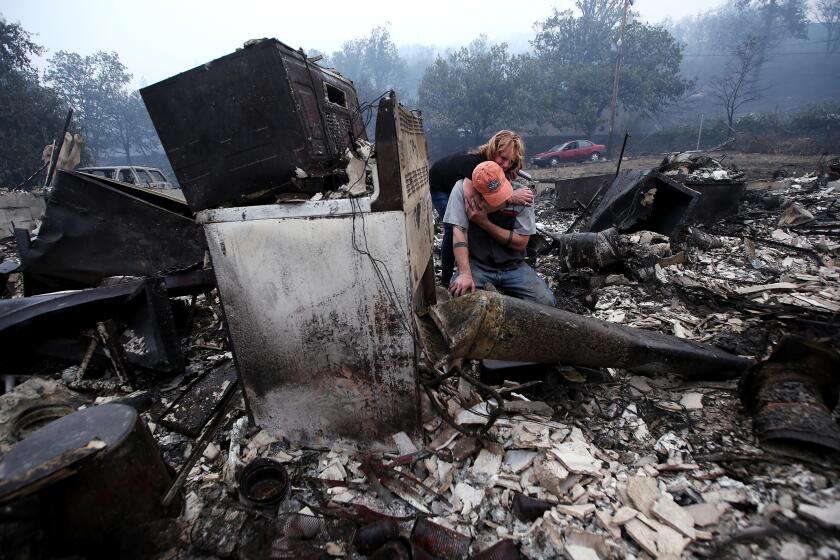State Farm accused of funneling excess profits to parent as it seeks rate hike

- Share via
State Farm General, California’s largest home insurer, is being accused of boosting the profits of its parent company at the expense of state policyholders — while claiming it’s in financial distress and in need of a 30% rate hike.
The company bought hundreds of millions of dollars of excess reinsurance from parent State Farm Mutual Automobile Insurance Co. over the past decade, while getting little back in return, according to Consumer Watchdog, a Los Angeles group that is challenging the hike.
Insurers buy reinsurance to protect themselves from catastrophic events that could put them out of business. It is often acquired from multinational firms that specialize in the product, but subsidiaries of large insurance companies sometimes buy reinsurance from a parent.
Even during the catastrophic fire years of 2017 and 2018, during which thousands of structures were destroyed by the Thomas fire in Ventura County, the Camp fire in Butte County and others, the company would have been better off not buying the reinsurance it got, the group alleges.
Major insurers have pulled back from California’s homeowners market, citing wildfires, inflation and other challenges. But there are steps at-risk homeowners can take now to secure coverage and at lower prices.
“Reinsurance is a main reason State Farm is asking for its massive 30% rate hike — but the company is overpaying for reinsurance and consumers shouldn’t foot the bill,” said Carmen Balber, executive director of the group.
State Farm declined comment on the allegations, saying it was “not appropriate” to do so while the rate filing is being reviewed by the state Department of Insurance.
“The appropriate place to share facts and bring clarity to this complex matter is within the formal rate filing process. We are prepared to do that,” said Sevag Sarkissian, a spokesperson for the State Farm insurance group.
State Farm General bought a total of $2.2 billion worth of homeowners reinsurance from multiple parties from 2014-23. It received $400 million back to cover claims, recovering a little less than 20% of what it paid for in reinsurance, according to calculations by Consumer Watchdog. The group estimates about two-thirds of the acquired reinsurance came from State Farm Mutual.
In making its allegations, Consumer Watchdog analyzed 10 years of reinsurance data filed by the number two, three and four California home insurers by market share: CSAA Insurance Exchange; California Automobile Ins. Co., a subsidiary of Mercury General; and Fire Insurance Exchange, a member of Farmers Insurance Group.
While Fire Insurance Exchange also purchased substantial amounts of reinsurance from its parent, Balber said all three companies received more reimbursements for every dollar of reinsurance they purchased than did State Farm — and especially benefited during the 2017 and 2018 fire years.
As an “intervenor” in the rate review — a process established by Proposition 103, the landmark 1988 insurance reform initiative spearheaded by Consumer Watchdog — the group has asked State Farm General to provide more details about its reinsurance agreements. Balber said it has yet to receive any documents.
Actuary James Naughton, a professor at the University of Virginia’s Darden School of Business, said that Consumer Watchdog had cause to question State Farm over its reinsurance practices since the parent company appeared to financially benefit from the arrangement.
“[They] are right to be suspicious of the fact that it’s basically a State Farm-to-State Farm movement of risk,” he said.
But he added that the reinsurance did protect State Farm General from catastrophic claims, and that reinsurance contracts are customized, making it difficult to draw definitive conclusions about them.
The allegations against State Farm General come not only as the company is seeking steep rate hikes in its homeowners — as well as its condominium and renters — policies, but after it said in March it would not be renewing 72,000 home, apartment and other property policies. It cited soaring reconstruction costs, increasing wildfire risks and outdated state regulations.
State Farm General also has already received significant home insurance rate increases, including a 6.9% boost in January 2023 and a 20% jump that went into effect in March.
The company is one of a number of California insurers that have either stopped writing new policies, withdrawn from the market, raised prices or tightened underwriting standards amid a sharp increase in wildfires attributed to climate change. Others include Farmers Insurance, the Hartford and Allstate, which is seeking its own 34% rate hike.
In response, Insurance Commissioner Ricardo Lara has proposed a series of reforms intended to stabilize California’s insurance market and attract insurers back into the market. Called the Sustainable Insurance Strategy, it includes a regulation that would allow insurers to pass through their reinsurance costs to policyholders.
Consumer Watchdog opposes the regulation, and Balber cited State Farm General’s reinsurance arrangements as “exhibit one” of why it’s not a good idea.
Michael Soller, the department’s deputy commissioner for communications, declined to respond to the criticism but said the group’s allegations about State Farm’s reinsurance practices “echo concerns” of regulators, who are seeking more information about State Farm’s financial status and its reinsurance arrangements as it reviews the request for a rate increase.
“Our goal is to hold all parties accountable in our thorough and transparent rate review. We are not going to make any decisions until we have our questions answered,” he said.
In filing for its rate increase, State Farm, which also sells auto, commercial and other policies, warned that its financial condition would deteriorate if it was not approved.
In a sign of financial trouble, State Farm General has asked for permission to dramatically increase insurance rates for millions of California homeowners and renters.
The company saw its net losses grow to $880 million last year from $98.4 million in 2022. However, losses narrowed to $53.8 million in the first six months of this year, according to rating agency A.M. Best, which this month rated the company’s financial strength as “B” with a stable outlook, meaning it had a “fair” ability to meet its financial obligations.
Parent State Farm Mutual Automobile Insurance Co., which lost $4.7 billion last year, earned $1.56 billion in the first six months of this year. This month it earned A.M. Best’s top financial strength rating of A++ but with a “negative outlook.”
More to Read
Inside the business of entertainment
The Wide Shot brings you news, analysis and insights on everything from streaming wars to production — and what it all means for the future.
You may occasionally receive promotional content from the Los Angeles Times.













